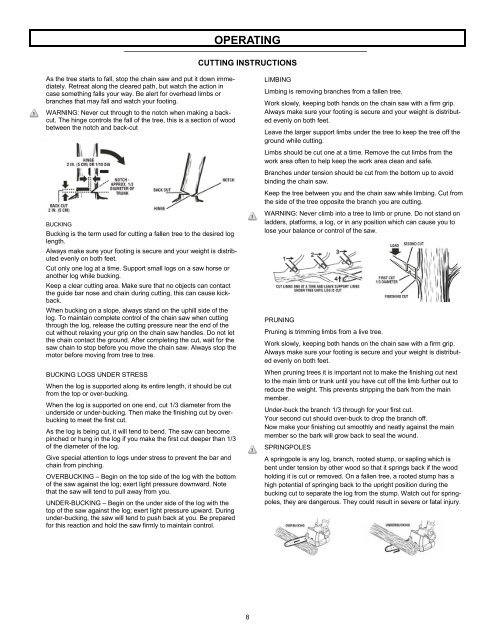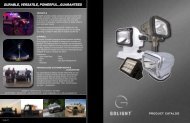Electric Chain Saw CS30014 CS30016.pdf - Dorian Drake ...
Electric Chain Saw CS30014 CS30016.pdf - Dorian Drake ...
Electric Chain Saw CS30014 CS30016.pdf - Dorian Drake ...
You also want an ePaper? Increase the reach of your titles
YUMPU automatically turns print PDFs into web optimized ePapers that Google loves.
As the tree starts to fall, stop the chain saw and put it down immediately.<br />
Retreat along the cleared path, but watch the action in<br />
case something falls your way. Be alert for overhead limbs or<br />
branches that may fall and watch your footing.<br />
WARNING: Never cut through to the notch when making a backcut.<br />
The hinge controls the fall of the tree, this is a section of wood<br />
between the notch and back-cut<br />
BUCKING<br />
Bucking is the term used for cutting a fallen tree to the desired log<br />
length.<br />
Always make sure your footing is secure and your weight is distributed<br />
evenly on both feet.<br />
Cut only one log at a time. Support small logs on a saw horse or<br />
another log while bucking.<br />
Keep a clear cutting area. Make sure that no objects can contact<br />
the guide bar nose and chain during cutting, this can cause kickback.<br />
When bucking on a slope, always stand on the uphill side of the<br />
log. To maintain complete control of the chain saw when cutting<br />
through the log, release the cutting pressure near the end of the<br />
cut without relaxing your grip on the chain saw handles. Do not let<br />
the chain contact the ground. After completing the cut, wait for the<br />
saw chain to stop before you move the chain saw. Always stop the<br />
motor before moving from tree to tree.<br />
BUCKING LOGS UNDER STRESS<br />
When the log is supported along its entire length, it should be cut<br />
from the top or over-bucking.<br />
When the log is supported on one end, cut 1/3 diameter from the<br />
underside or under-bucking. Then make the finishing cut by overbucking<br />
to meet the first cut.<br />
As the log is being cut, it will tend to bend. The saw can become<br />
pinched or hung in the log if you make the first cut deeper than 1/3<br />
of the diameter of the log.<br />
Give special attention to logs under stress to prevent the bar and<br />
chain from pinching.<br />
OVERBUCKING – Begin on the top side of the log with the bottom<br />
of the saw against the log; exert light pressure downward. Note<br />
that the saw will tend to pull away from you.<br />
UNDER-BUCKING – Begin on the under side of the log with the<br />
top of the saw against the log; exert light pressure upward. During<br />
under-bucking, the saw will tend to push back at you. Be prepared<br />
for this reaction and hold the saw firmly to maintain control.<br />
OPERATING<br />
CUTTING INSTRUCTIONS<br />
8<br />
LIMBING<br />
Limbing is removing branches from a fallen tree.<br />
Work slowly, keeping both hands on the chain saw with a firm grip.<br />
Always make sure your footing is secure and your weight is distributed<br />
evenly on both feet.<br />
Leave the larger support limbs under the tree to keep the tree off the<br />
ground while cutting.<br />
Limbs should be cut one at a time. Remove the cut limbs from the<br />
work area often to help keep the work area clean and safe.<br />
Branches under tension should be cut from the bottom up to avoid<br />
binding the chain saw.<br />
Keep the tree between you and the chain saw while limbing. Cut from<br />
the side of the tree opposite the branch you are cutting.<br />
WARNING: Never climb into a tree to limb or prune. Do not stand on<br />
ladders, platforms, a log, or in any position which can cause you to<br />
lose your balance or control of the saw.<br />
PRUNING<br />
Pruning is trimming limbs from a live tree.<br />
Work slowly, keeping both hands on the chain saw with a firm grip.<br />
Always make sure your footing is secure and your weight is distributed<br />
evenly on both feet.<br />
When pruning trees it is important not to make the finishing cut next<br />
to the main limb or trunk until you have cut off the limb further out to<br />
reduce the weight. This prevents stripping the bark from the main<br />
member.<br />
Under-buck the branch 1/3 through for your first cut.<br />
Your second cut should over-buck to drop the branch off.<br />
Now make your finishing cut smoothly and neatly against the main<br />
member so the bark will grow back to seal the wound.<br />
SPRINGPOLES<br />
A springpole is any log, branch, rooted stump, or sapling which is<br />
bent under tension by other wood so that it springs back if the wood<br />
holding it is cut or removed. On a fallen tree, a rooted stump has a<br />
high potential of springing back to the upright position during the<br />
bucking cut to separate the log from the stump. Watch out for springpoles,<br />
they are dangerous. They could result in severe or fatal injury.




